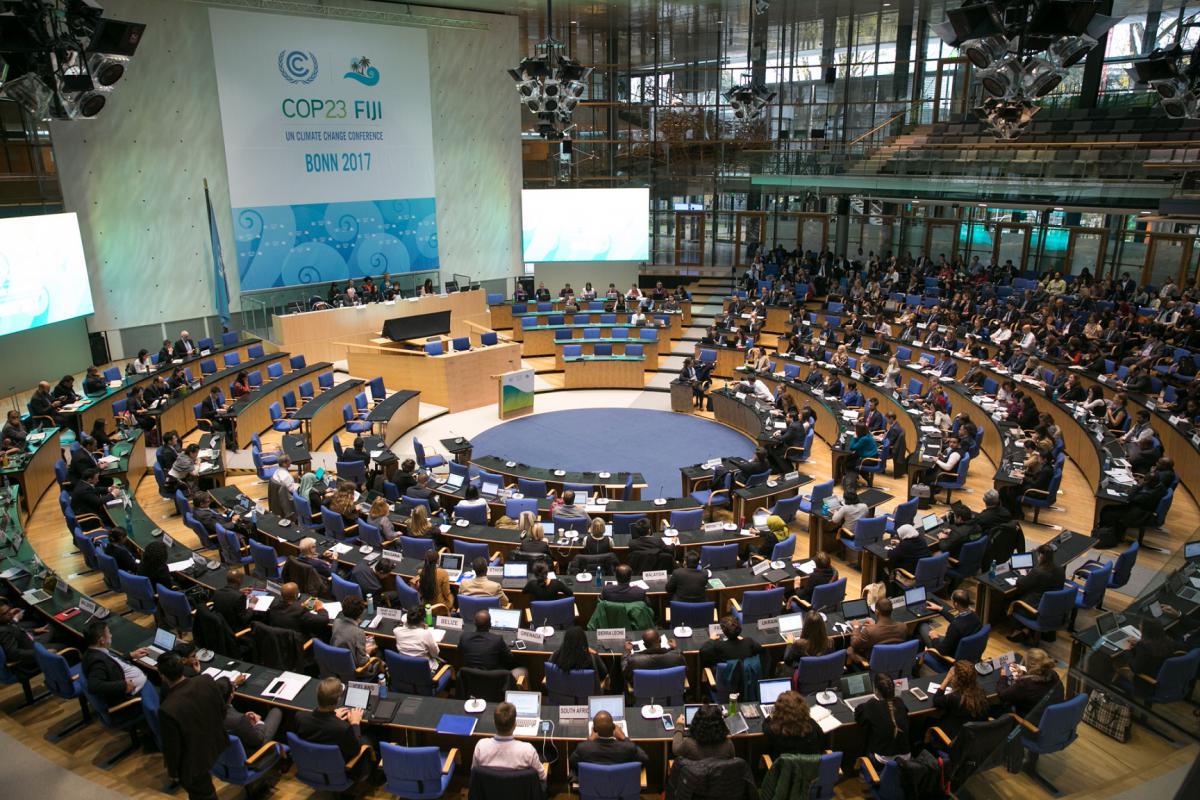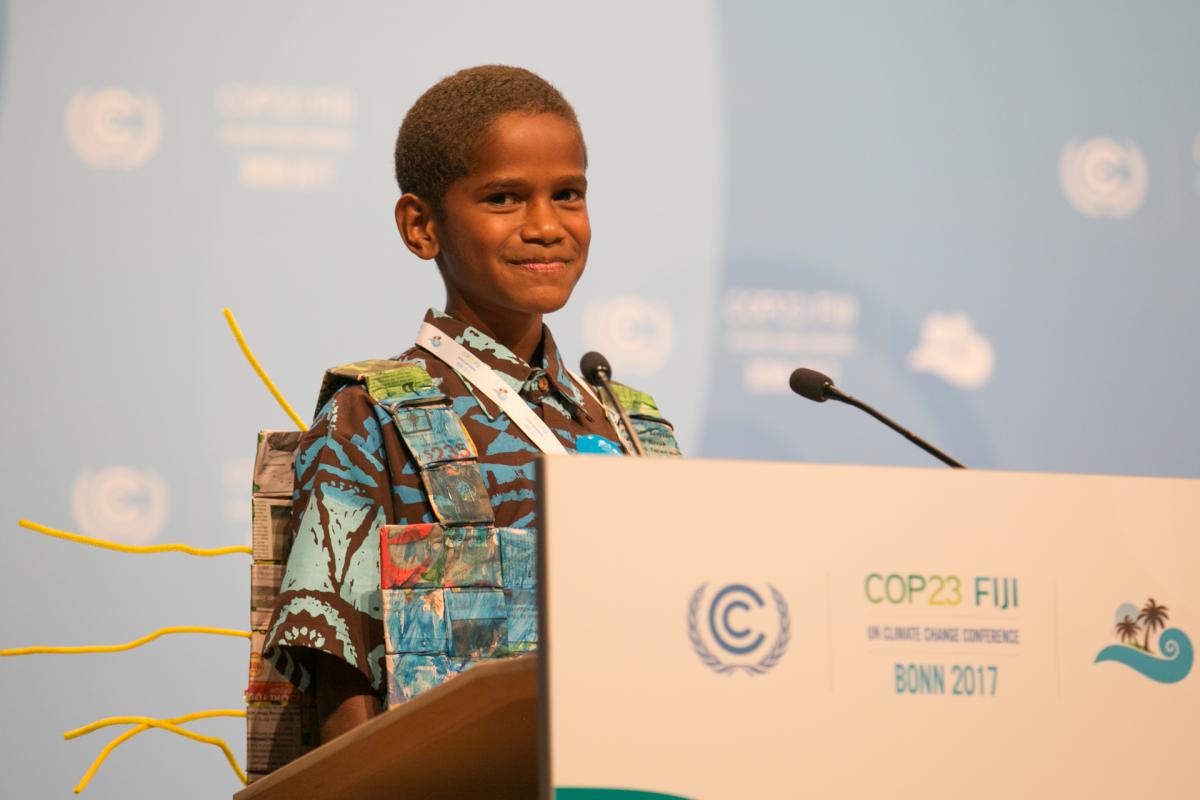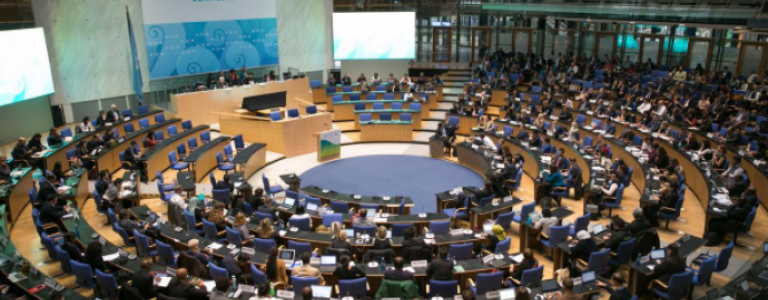Looking Back on the “Caterpillar COP”
Was COP 23 really the 'Caterpillar COP'? Phil Gass and Frédéric Gagnon-Lebrun take look back, and remind us that caterpillars are ultimately destined to emerge as butterflies...
Progress at the 23rd Conference of the Parties (COP 23), the United Nations climate change conference that recently wrapped up in Bonn, Germany, has been likened by the Earth Negotiation Bulletin to that of a caterpillar weaving a cocoon with the hope of revealing a butterfly in the end.
The metaphor is a symbolic representation of the process to develop a set of rules that will guide countries in the implementation of the Paris Agreement. At the last conference, held in Marrakesh in 2016, countries agreed to give themselves two years to negotiate these rules, with a view of adopting them as a “package deal” in 2018.
The image also brings to mind The Very Hungry Caterpillar, a popular children’s book by Eric Carle. In that story, a caterpillar with an insatiable appetite overeats and gets sick before weaving a cocoon to emerge as a beautiful butterfly.
The current state of negotiations is a bit like the caterpillar after eating cake, cheese, ice cream, pickles, salami, lollipops, cherry pie, sausages, cupcakes and watermelon. After COP 23, the Ad Hoc Working Group on the Paris Agreement (APA) informal note that forms the basis of negotiations had ballooned to 266 pages covering five main items (mitigation, adaptation communication, transparency framework, global stocktaking and compliance). This included 180 pages on the topic of mitigation alone. Much like the caterpillar, the text has left some negotiators feeling bloated.
The good news is that, after some rest and recovery, it all worked out for the caterpillar, and there is certainly much hope for the negotiations ahead as well.

Starting the Metamorphosis
Overall, this COP was very technical, but no technical issue is apolitical. The first conference following the United States’ announcement of its intention to withdraw from the Paris Agreement saw a new geopolitical dynamic at play. In the lead up to Paris, the United States and China had become balancing forces. While the United States is still at the negotiating table, their much-reduced legitimacy allows China greater ability to drive negotiations in their preferred direction.
This has led to a re-emergence of the much fraught binary interpretation of the principle of “Common but differentiated responsibilities and respective capabilities, in light of different national circumstances,” found throughout the Paris Agreement. This interpretation, defended with most conviction by China, but also by India and Saudi Arabia, calls for a clear division between developed and developing countries’ responsibilities across most topics. Efforts by the European Union, Canada and others to offer a counterweight is much needed to keep a more nuanced differentiation between countries, in line with the spirit of the Paris Agreement.
Canada’s Presence: Coal and collaboration
The highest profile event for Canada was the launch of the Powering Past Coal Alliance, spearheaded by Canada and the United Kingdom with the goal of building momentum on phasing out coal power internationally. Members who sign on agree to phase out existing coal and place a moratorium on new coal power plants without carbon capture. The group has 27 members currently, including four provinces and the City of Vancouver. The hope is that this group will grow to 50 members by COP 24. The involvement of cities and provinces in this alliance is also representative of Canada’s presence at COP 23, characterized by the engagement of provincial and territorial governments. Beyond the federal delegation, Canada’s subnational delegations again prominently showcased their actions and called for greater ambition, bringing their support to a large delegation of U.S. subnational leaders past (former New York City mayor Michael Bloomberg, former governor Arnold Schwarzenegger) and present (Governors Jerry Brown, Kate Brown, Terry McAuliffe and Jay Inslee, and multiple mayors).
Overall, this COP was very technical, but no technical issue is apolitical.
From a negotiations standpoint, Canada had a lower profile but continued to support the negotiations, offering supportive statements to scale up climate finance to the USD 100 billion dollar 2020 goal, facilitating discussions on the adaptation communications component of the APA, pro-actively speaking on markets issues, as well as facilitating discussion on the Warsaw International Mechanism on loss and damage.
Canada also played a key role in the adoption of a Gender Action Plan and the operationalization of the Local Communities and Indigenous Peoples Platform, both of which it supported with events in Ottawa earlier this year. Canada’s more public presence, like many countries, was in the events-focused “Bonn zone” rather than the much lower-key (but just as impactful) negotiations-focused “Bula zone.”
Looking Ahead
As negotiations on the rules to guide the implementation of the Paris Agreement continue, 2018 will also be marked by stocktaking exercises. One key achievement of COP 23 is to have landed on the design of a year-long assessment of progress, to start in early 2018. The Talanoa Dialogue—named after a Pacific storytelling tradition that fosters openness and trust and that was the trademark of COP 23—aims to take stock of progress in view of the latest scientific findings and inspire countries to achieve their targets and design their next mitigation pledges.
Fiji, the first small island developing state to preside over a COP, infused the talks with a strong sense of urgency to act. This may have led to an important win for developing countries: making countries that have made pledges for 2020 more accountable, a long-time ask of developing countries. Countries that made 2020 mitigation pledges in Cancún in 2010 will be asked to present on progress made in achieving these at COP 24 and COP 25. Similarly, developed countries are asked to provide more information on how they intend to achieve the goal of mobilizing USD 100 billion per year by 2020. After all, these are the very pledges and goals that instilled the trust between countries that was necessary to reach an agreement in Paris.

The Butterfly Emerges
The solution for the Very Hungry Caterpillar when he overate was to rest, eat a sensible single green leaf and spin his cocoon. Negotiators will also have to adopt a more sensible, restrained diet if they are to avoid the problems of the past, when texts became overfed. Much division remains, and the lack of clarity on where these divisions are most prominent is reflected in the pages of options on all issues.
Transitional COPs like the one that just ended in Bonn are typified by the usual positioning and posturing that occurs before a deadline. COP 23, however, gave parties a chance to have a more informed discussion, to better detail their positions and to start clarifying the possible structure of a decision text. The stage is now set and the real negotiation and bargaining must start.
The good news is that, after some rest and recovery, it all worked out for the caterpillar, and there is certainly much hope for the negotiations ahead as well.
As Poland takes over to preside over COP 24, the challenge will be to create a constructive atmosphere that allows countries to negotiate in good faith and on the basis of the precarious balance achieved in Paris, so that compromises can be reached across all issues. Time is short and the option of adding a negotiation session before COP 24 is on the table so that convergence can be achieved in Poland.
That said, the shadows of the protracted past still do create unease and uncertainty, despite hope for progress. Will the butterfly emerge in time for the 2018 deadline?
You might also be interested in
Capping Potential Blowouts
This policy brief argues that the oil and gas emissions cap is necessary but cautions that some of its compliance flexibilities may amount to a critical weakening.
Credit Check
Debunking the myth that Canada can get credit under Paris Agreement Article 6 for its clean energy liquefied natural gas (LNG) exports.
October 2024 | Carbon Minefields Oil and Gas Exploration Monitor
In September 2024, a total of 19 oil and gas exploration licences were awarded across eight countries, with a concerning estimated volume of embodied emissions reaching 147.1 million metric tons of CO2.
How Can a Fossil Fuel Levy Cut Emissions and Finance Climate Action?
A levy on extracting fossil fuels could reduce emissions and help finance climate action. How can governments implement the most effective fossil fuel levy?
